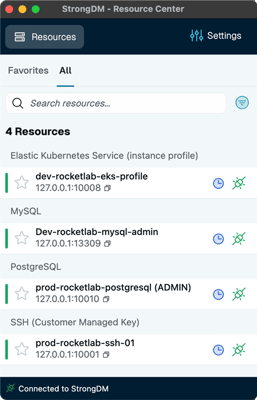Now we've adopted StrongDM — it's something you don't even know is there. Once it's installed, it just works. It's very simple.

Now we've adopted StrongDM — it's something you don't even know is there. Once it's installed, it just works. It's very simple.




The effort to achieve SOC 2 compliance without StrongDM would have been a monumental effort, not only in terms of resources, but in terms of cost.


The team at StrongDM has been exceptional. We haven't had many support requests at all because the product just works the way that it's supposed to.

StrongDM is committed to delivering a great product and pairing with us to ensure that the product is the correct solution for us. While I can't speak to their competition, I can say that their willingness to improve their products based on feedback sets them apart from the rest.
StrongDM allows us to sync Okta roles to AWS IAM roles without having to assign permissions statically.

We like that StrongDM is simple to use for admins and end users. For the most part, we don't notice SDM is there, which is exactly what we want. Users that were initially skeptical have been impressed and prefer StrongDM to the old way of doing things.
Our primary focus was secure, revo and short lived ssh access to resources. No more sprawling SSH keys, and database access is a lot easier and more secure.

Onboarding and rollout were so quick. We onboarded over 300 employees in just one week.
Per audit requirements, we were forced to manage and control users' access to production systems. StrongDM offers an easy way to do it.

What do I like best can easily be summed up by saying "it just works". Since we initially on boarded with StrongDM the solution has worked for us. As with anything there have been minor hiccups but their support team is quick to email or hop on a zoom and resolve these hiccups. It's been easy enough for all of our teams, even the less technical ones, to use without the need for significant training.
We found StrongDM when we were starting down our compliance path, starting with SOC 2 Type II compliance. StrongDM helped us protect our cloud resources with private networks but still allows employees to connect to these resources when necessary. Plus it adds all the necessary audit trails.

From the Admin side, it's intuitive and expansive. It's so nice to have a single pane of glass to manage different access to resources; but a killer feature is granting temporary access. As teams change, people go on-call, or various other changes happen, roles can be dynamically changed and updated- all autonomously after rules are established. This minimizes overhead, greases the wheels and gets developers, auditors, directors; whoever the right access they need every time without having to step in.
We're using SSO tools that mainly give FE access; but configuring these tools individually for backend access is much more of a challenge (and on some services, tiered). Using this product allows us to speed up Onboarding, Access Management, and reducing management overhead drastically. Being able to link from an SSO provider all the way down to an IAM role for a specific resource (or dynamic resources based off of tags), while having a FULL audit trail is incredible.

It has helped us avoid the need to manage database usernames and passwords for routine access; Helped answer questions like Who, When, What, and Where on a Splunk Dashboard; Automating onboarding/off-boarding, and a simplified manager approval process thanks to slack integrations.
Getting access to data was not trivial. It was time consuming for both DBAs and Engineers. Thanks to strongDM we were able to achieve better operational efficiency.

“Security is a necessary part of day-to-day life. In terms of how we go forward, StrongDM will continue to be part of that story. It has all the mechanisms in place for database access control that we require, and I haven’t found a competitor yet that does the same thing.”
“We chose StrongDM because the solution is the one solution to rule them all. You simply integrate all your data sources into StrongDM; you integrate all your servers into StrongDM; you integrate all your Kubernetes clusters into StrongDM. You give your developers one simple tool they need to connect using SSO, and they have access to what they own.”
“Clearcover remains committed to the industry’s best security practices. StrongDM provides us with better insights to bolster our security posture.”
“I would urge all other CISOs to adopt strongDM as their database proxy platform. It's been amazing for all of our users. When we first got strongDM, we implemented within, I think a day. And within a week we saw more and more users requesting access to it, once they saw how easy it was to access databases.”
“With StrongDM, people don't have to maintain usernames and passwords for databases. With servers, they don't have to have keys. For websites, they don't have to have passwords. And so when you start eliminating the need for passwords and you start looking at things like Zero Trust, I believe that the attack surface is completely reduced.”
“With StrongDM, people don't have to maintain usernames and passwords for databases. With servers, they don't have to have keys. For websites, they don't have to have passwords. And so when you start eliminating the need for passwords and you start looking at things like Zero Trust, I believe that the attack surface is completely reduced.”






